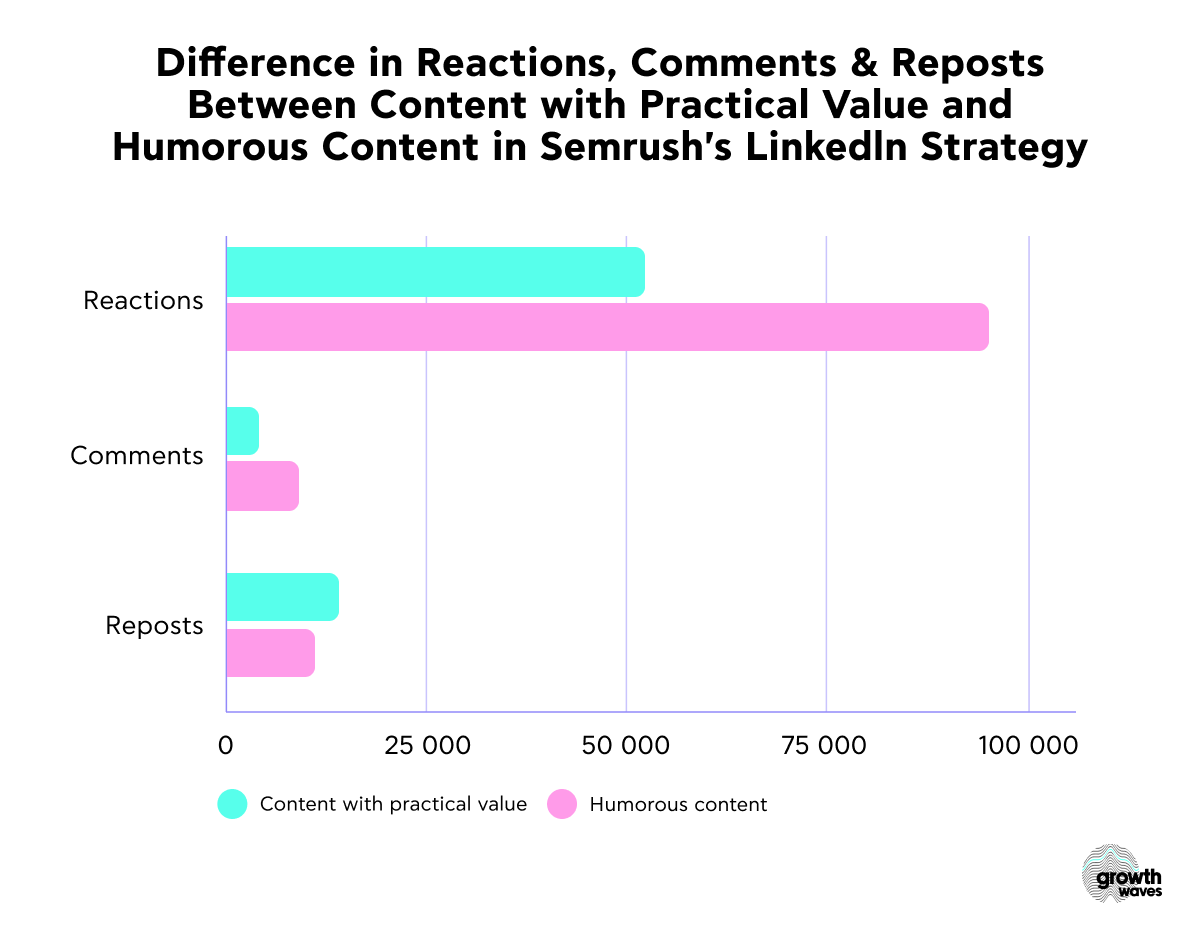This company gets LinkedIn virality
The LinkedIn playbook behind Semrush’s viral posts
👋 Hey, I’m George Chasiotis. Welcome to GrowthWaves, your weekly dose of B2B growth insights—featuring powerful case studies, emerging trends, and unconventional strategies you won’t find anywhere else.
Recently, I was browsing my LinkedIn feed when I saw a post from a well-known company in the marketing & SEO community.
The way this post spoke to the pain points of its target readers was incredible.
“These folks really know their audience…”
Then, I looked at the number of engagements this post collected.
Over 4K.
This company really knows its way around going viral on LinkedIn!
What’s its secret?
The search for the answer got me tracking data almost 12 months back.
And I have found it.
Key findings
Here’s the quick TL;DR of the note before we begin.
Semrush publishes about 26 posts a month on LinkedIn. This data is based on the period between June 2023 and May 2024 chosen for analysis.
Two content types dominate Semrush’s LinkedIn content. These are posts on SEO & marketing and humorous content. The company publishes about 12 such posts per month on average.
These content types also get the most engagement. On average, posts providing practical value gain 1,537 engagements, and humorous content gets 1,575 engagements.
The ratio of such high-performance posts is quite high. Of 314 posts Semrush published between June 2023 and May 2024, 112 (~36%) collected over 500 reactions.
But are these posts necessarily viral?
And, if yes, which virality patterns do they display?
Let’s find out.
Semrush’s LinkedIn strategy: An overview
From a general look, I’d describe Semrush’s LinkedIn strategy with one word.
Consistency.
This consistency is visible, first and foremost, in the publishing schedule.
I tracked the number of posts Semrush published on LinkedIn a month as far back as June 2021, and here’s what I found.
As you can see, the publishing schedule follows a certain pattern, with an average publishing velocity of 26 posts per month.
What about consistency in content?
A detailed look at Semrush’s presence on LinkedIn shows that they mostly go heavy on the following post types:
Announcements;
Posts about SEO & marketing (industry-related);
Memes and humorous content;
Case studies.
Although all of these post types are (more or less) present on a monthly basis, two definitely stand out.
Take a look.
Editor’s Note: This categorization may not reflect the pattern followed by Semrush’s social media team.
So, posts on SEO & marketing (delivering practical value) and humorous content are consistently present in Semrush’s monthly LinkedIn content strategy.
However, depending on the month, one type seems to dominate over the other.
Interestingly, these post types are also more likely to collect the most engagements in Semrush’s case.
Let me give you an example.
Semrush made 32 LinkedIn posts in April 2024.
53% (17) of these posts gained over 500 engagements.
Which post type dominated?
Semrush’s audience seems to prefer industry-related jokes and memes.
Given all this data, can we consider Semrush’s LinkedIn content viral?
Yes and no.
Virality, in its general sense, implies more engagement since it means a company’s content has reached vast audiences, beyond the people it usually engages with.
Yet, given the number of engagements its posts collect, Semrush’s content can be considered viral within the limits of the digital marketing and SEO industry.
Besides, it carries the traits characteristic of viral content in general.
Which ones?
Let’s dive deeper.
5 virality patterns in Semrush’s LinkedIn strategy
To study the virality patterns, I tracked Semrush’s content back to June 2023.
Since then, the company made 314 posts, 112 of which showed high engagement (collected at least 500 reactions).
42 of these posts covered something of a practical value, while 70 contained more humorous content, such as memes.
Needless to say, they performed differently in terms of engagements, especially when it comes to reactions.
What goes into such high performance?
Let’s find out.
Pattern #1: Following viral triggers
Since memes and humorous content attract the most attention from Semrush subscribers, let’s start with them.
Why are people so eager to share such posts?
One concept that could explain this is a viral trigger.
Jonah Berger, the author of the book Contagious: Why Things Catch On, defines a trigger as a “stimulus that reminds us of related products or ideas.”
A viral trigger can also relate to a trending topic, and Semrush capitalizes on such triggers a lot in its humorous content.
Examples?
Consider this rather witty way the company used the recent solar eclipse to create a promotional but humorously nonchalant post.
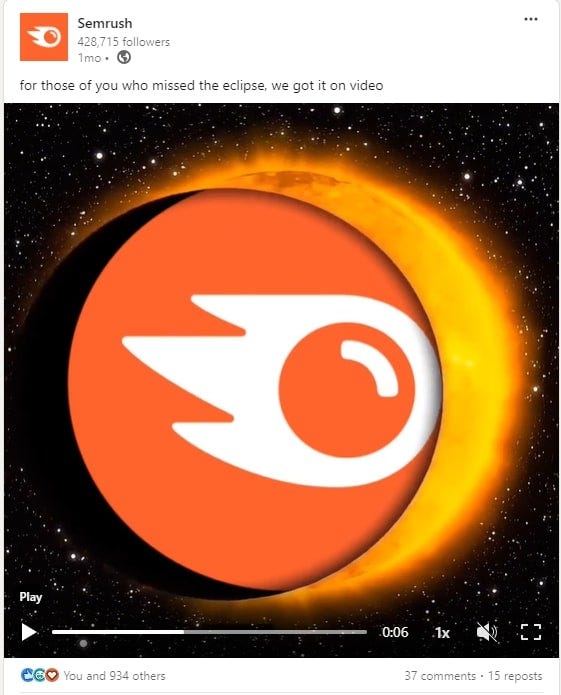
The post went live on 8 April 2024—the exact date of the eclipse.
And that’s what matters the most here.
As soon as you see a trigger, immediately jump on the bandwagon.
In this case, the search was exploding with all sorts of information on the event of the eclipse between the seventh and thirteenth of April.
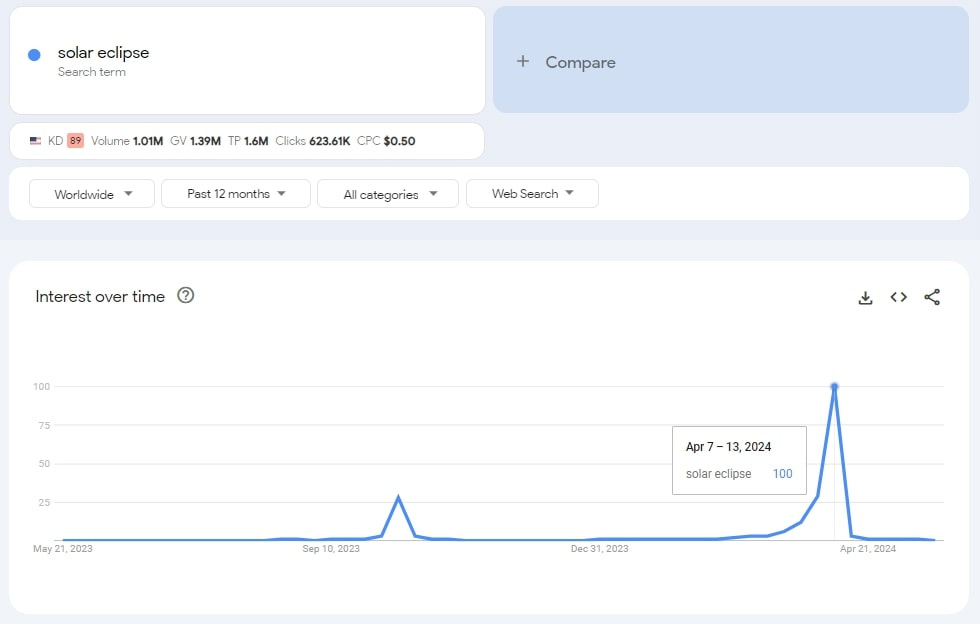
So, Semrush only had to tie it to something relevant to its audience (its product), and there you have it.
A viral trigger was associated with the company.
Here, we have an example of a trigger relevant to broader audiences.
What about the industry relevant to Semrush?
The same rule applies here, too.
For instance, Semrush often capitalizes on ChatGPT.
The related post below collected 3,599 and 647 reposts, in particular.
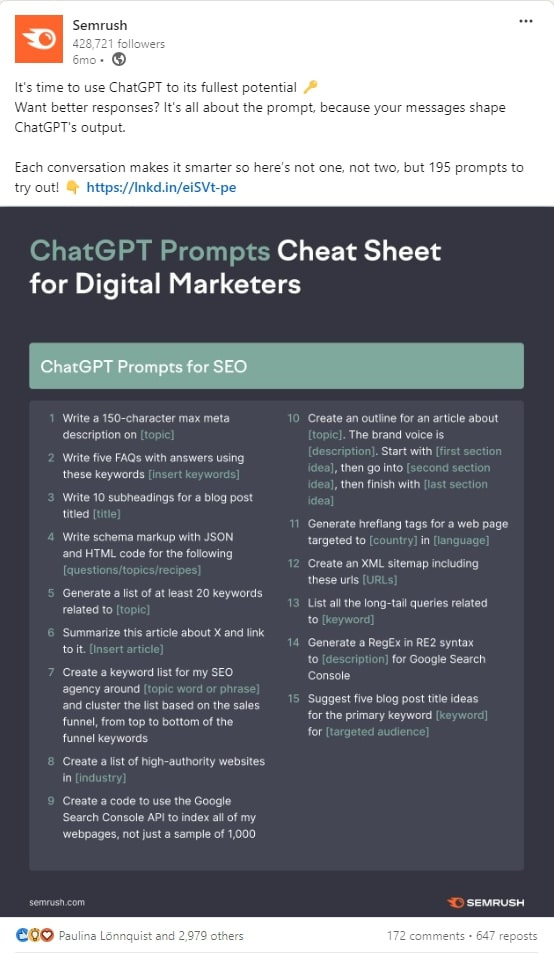
Such high engagement was possible because ChatGPT has remained a highly trending topic for almost two years.
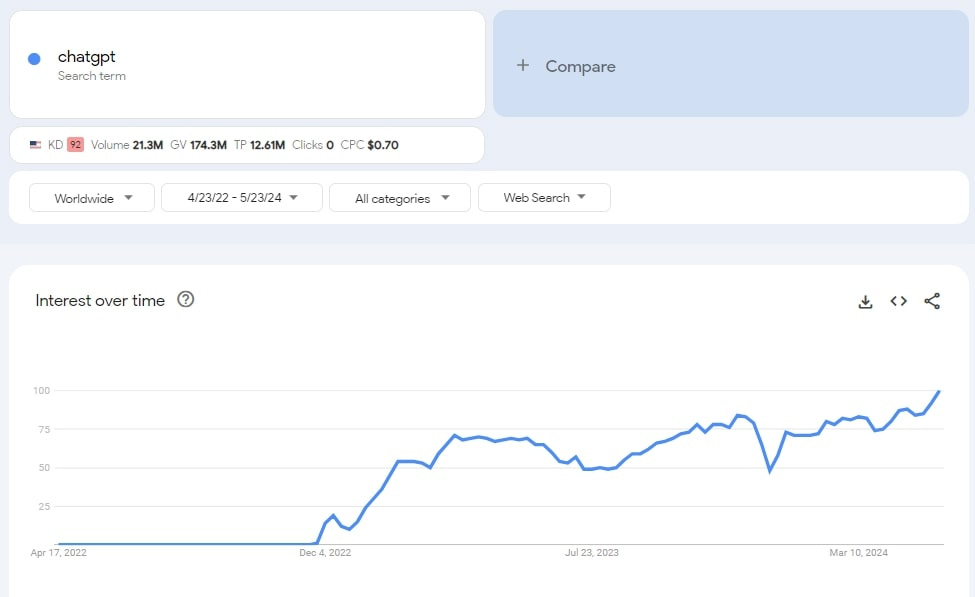
Obviously, not every viral trigger is worth your attention.
We can clearly see from these two examples that Semrush cherry-picks those trends that its audience can relate to.
And this leads me to the next pattern.
Pattern #2: Understanding the target audience
Take a look at the post below.

This post, published on 27 June 2023, collected a whopping 7,959 engagements (~2% engagement rate), but not just because it covered a trending topic of Google updates.
Editor’s Note: After the March 2023 Core Update, Google announced the next one for August 2023, which impacted the data in Google trends.
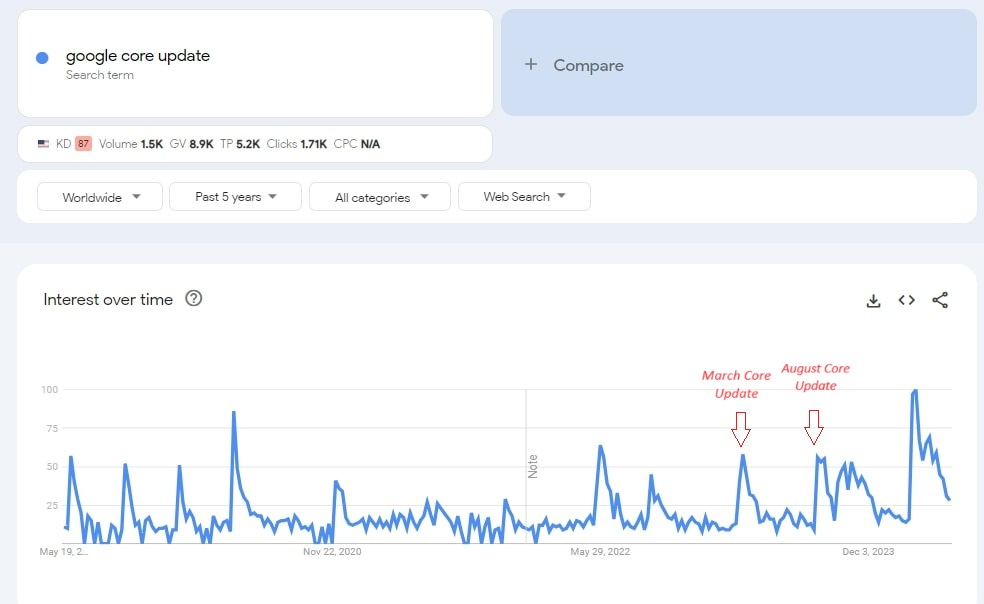
It most likely got so many reactions because Semrush’s audience (digital marketers and SEO specialists) felt fed up with the constant flow of Google updates.
Much like the otter in the video trying to stop the water stream.
Thus, Semrush’s posts go viral not because they are topical.
They address their audience’s interests and pain points.
Here’s another excellent example of this pattern in action.

The post above collected the terms that mean something different to marketers compared to “normal” people.
Semrush’s followers found it extremely relatable, as the post collected 4,283 engagements (1% engagement rate).
I must say, most of Semrush’s “viral” posts include content relevant to its audience’s needs and interests.
In fact, out of 112 high-engagement posts I collected from June 2023 to May 2024, 52% addressed at least one pain point common to marketers.
The same percentage of posts display another viral pattern—addressing emotions.
Let’s talk about that more.
Pattern #3: Appealing to emotions
Emotions are a powerful social currency.
They reflect how people want to be seen and their self-image.
Appealing to this self-image creates a connection, a bond that can prompt content to go viral.
Semrush seems to be really succeeding at that.
Check out the post below.

It refers to the familiar feeling of excitement on the first day at a marketing job vs. some time later when you have already faced all the trials and tribulations.
Relatable, right?
Much like this one.

The number of engagements (3,343 in total) shows that people clearly find it frustrating when their campaign ideas get rejected.
There are a whole lot of similar frustrations and other emotions that marketers find highly relevant.
And Semrush seems to know all about them.
Here are the most common relatable situations of a marketer the company addresses in its posts.
Knowing what its audience goes through every day helps Semrush build a meaningful connection with its followers, thus inducing hire shareability.
However, it’s not the only way the company facilitates positive relationships with its audience.
Let me explain.
Pattern #4: Building a connection
The 112 high-engagement posts I’ve pinpointed in the period between June 2023 and May 2024 together collected 8,170 comments.
It’s about 73 comments per post.
What’s the formula for such success?
Targeting trending topics is only a part of the equation here.
Replying to comments is also at play.
Many top-performing posts (in terms of comments) include several interactions between Semrush and the commentators.
For instance, the company’s team answered 49 out of 167 comments under the following post.

That’s on top of reacting to almost every single comment.
Semrush often takes it one step further.
The company sometimes reacts to and comments on the posts tagging it.
Minuttia’s own content marketing specialist Zach Xiroudakis, got a reaction from Semrush when promoting the new issue of our Adaptive Content Marketing newsletter.
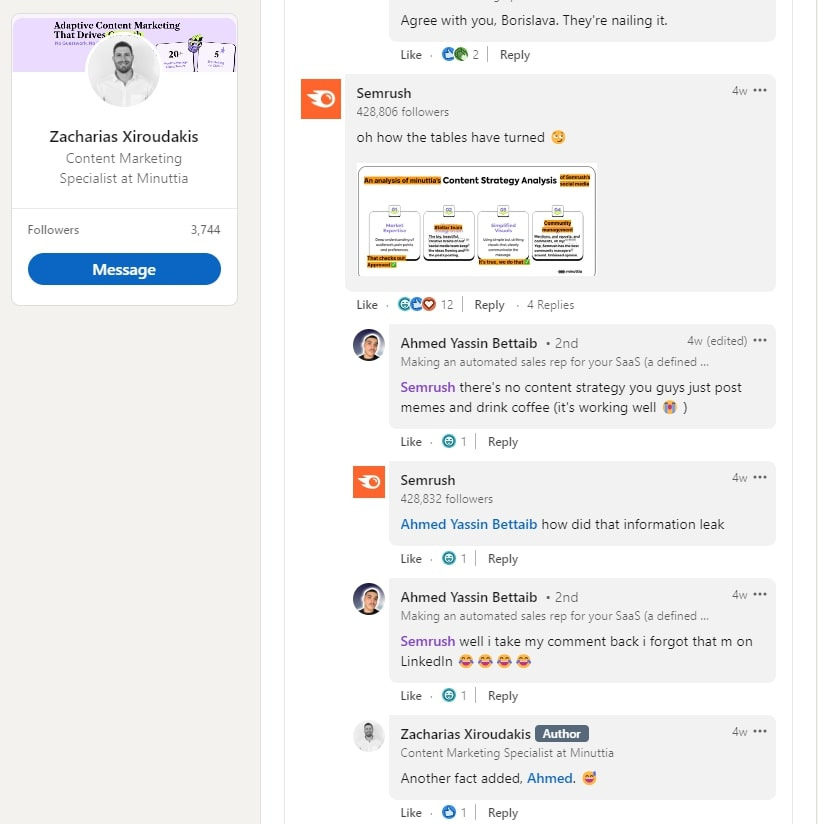
I’ve also noticed this tendency while scrolling through other posts on LinkedIn mentioning Semrush.
The brand’s team often reacts to people getting Semrush certifications, promoting the company’s tool, and sharing their reports.
Semrush’s actionable content also gets many shoutouts.
Let’s talk more about that.
Pattern #5: Giving practical value
I already mentioned that some of Semrush’s top-performing posts on LinkedIn provide actionable industry-related resources.
These are primarily frameworks, checklists, workflows, and my personal favorite—templates, like the one below.
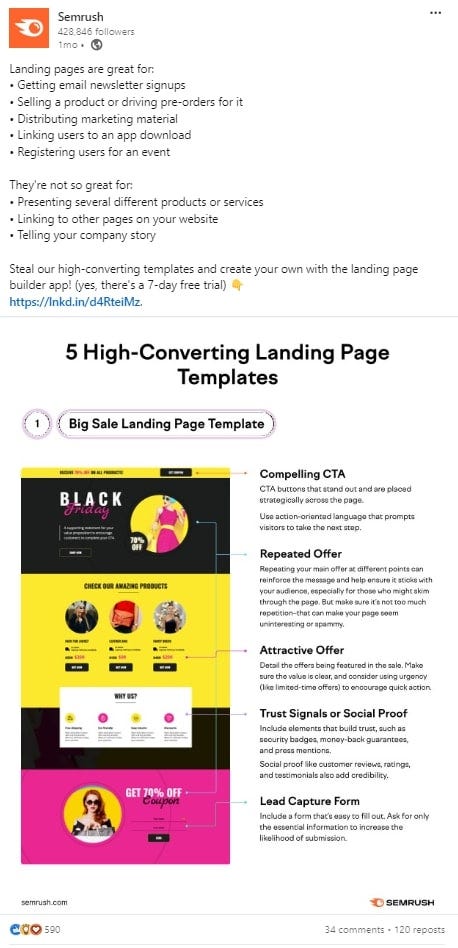
Such posts usually cover one of the following topics (with SEO and content marketing being the most popular).
Such posts also get great engagement, especially in terms of shares.
Out of 112 high-performance posts, 42 cover practical advice. Together, they collected 10,480 shares along with many reactions and comments.
It means that each such post collects 1234 reactions, 54 comments, and 250 shares on average.
The reason why people engage with this content so much is threefold.
It’s actionable, and marketers can easily apply it to their everyday tasks;
It comes from an authoritative source;
It’s easy to pass on to others.
Practical value as a virality pattern is one of the easiest to scale, too, especially on LinkedIn, where people share such content all the time.
And Semrush is an excellent example of how you can capitalize on it.
Conclusion
Let’s face it.
Virality sometimes gets a bad rep.
Oftentimes, companies try to go viral for all the wrong reasons, forgetting that it should be done with the goal of delivering value and building meaningful connections in the first place.
That’s what Semrush’s LinkedIn strategy is all about.
Through simple visuals and short posts, you get market expertise and actionable insights, while feeling part of a community of people who can relate to your interests and pain points.
It’s definitely an example worth following, don’t you agree?
See you next week!








